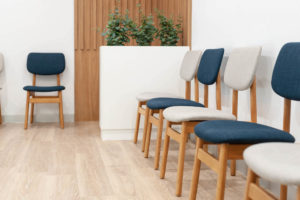Our physical environment plays a huge role in influencing how we feel, even if we sometimes aren’t fully aware of it. This is particularly true when it comes to a medical setting such as a GP clinic or therapist’s office where people might feel nervous or uncomfortable. The design of practices and counselling spaces plays a significant role in the patient experience. A practice fitout that is carefully considered and thoroughly planned during the design phase will positively impact a patient’s experience.
A therapeutic space that is open and bright will feel infinitely more inviting than a dark, poorly laid out space. These disorderly spaces directly impact the client experience, as well as the individuals working in those environments. This in turn has a knock-on effect on the outcomes and experiences for everyone involved. Different elements such as colours, layout, and furniture in the design of a therapeutic space, play a role in influencing behaviour, cognition, and mood.
Let’s take a more in-depth look at the various aspects of design which all have a unique role or function that informs the construction of therapeutic spaces.
Windows – Where possible, windows should be kept open to let in sunlight and a gentle breeze. A more natural setting that evokes an inside-outside feeling will make the client feel more peaceful and at ease.
Nature – Research shows that greenery such as plants and flowers, access to outdoor spaces (if possible), or views of tranquil landscapes from a counselling or practice room can be hugely beneficial for not only client comfort but mental health.
Seating – Chairs should be comfortable and provide enough back support, as well as be adjustable and easy to move around should the client want to reposition themselves during their session.
Colour – When it comes to picking paint colours or wallpaper patterns, it is advised to opt for light, soothing tones such as pastel blues or sage greens, as these are often found in nature and promote a sense of serenity and calm.
Lighting – Bright spaces are more appealing than the dark, but it is important for the client to feel as comfortable as possible in a space. The option to have adjustable or dimmable light may be required, as it is important to address the needs of each individual as everyone is different.
Furniture – Think functionality, style, and placement. Clients and staff will spend significant time using this furniture. Only choose what you need and what compliments the space.
Soft Furnishings – Items such as pillows and blankets as well as rugs or carpets can be utilised in a space to create a soothing environment for a client.
Art – Choosing appropriate artwork for the practice can be a fun and enjoyable part of the decoration process. Choose art that is soothing and neutral. Often nature-based artworks are used in these settings as they can help promote a sense of calm.
Now for the ‘what not to do’.
Fixed Seating – Having seating that can be adjusted to suit the client gives them a sense of control and prevents them from feeling like they can’t move around, which could potentially make them feel uncomfortable.
Enclosed Spaces – Clients are visiting your practice to share personal, intimate details about themselves to gain healing. Cramped, tight conditions are unsuitable and could make your client feel oppressive and claustrophobic.
Potential Triggers – Consider potential triggers when choosing personal effects and artwork. Anything portraying sadness, death, or violence can be triggering for a lot of clients.
Taking these elements into consideration will encourage a better design of therapeutic spaces. The goal here is to make sure that the environment you’re creating is safe and welcoming.




